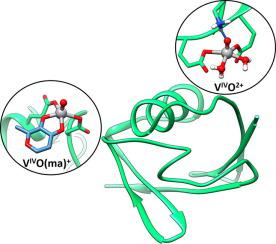Coordination Chemistry Reviews ( IF 20.3 ) Pub Date : 2021-09-21 , DOI: 10.1016/j.ccr.2021.214192 João Costa Pessoa , Marino F.A. Santos , Isabel Correia , Daniele Sanna , Giuseppe Sciortino , Eugenio Garribba

|
The understanding of the role of vanadium enzymes and of vanadium compounds (VCs) in biology, as well as the design of new vanadium-based species for catalysis, materials science and medicinal chemistry has exponentially increased during the last decades. In biological systems, VCs may rapidly interconvert under physiological conditions and several V-containing moieties may be formed and bind to proteins. These interactions play key roles in the form transported in blood, in the uptake by cells, in inhibition properties and mechanism of action of essential and pharmacologically active V species. In this review, we focus on the recent advances made, namely in the application of the theoretical methodologies that allowed the description of the coordinative and non-covalent VC–protein interactions. The text is organized in six main topics: a general overview of the most important experimental and computational techniques useful to study these systems, a discussion on the nature of binding process, the recent advances on the comprehension of the V-containing natural and artificial enzymes, the interaction of mononuclear VCs with blood and other physiologically relevant proteins, the binding of polyoxidovanadates(V) to proteins and, finally, the biological and therapeutic implications of the interaction of pharmacologically relevant VCs with proteins and enzymes. Recent developments on vanadium-containing nitrogenases, haloperoxidases and nitrate reductases, and binding of VCs to transferrin, albumins, immunoglobulins, hemoglobin, lysozyme, myoglobin, ubiquitin and cytochrome c are discussed. Challenges and ideas about desirable features and potential drawbacks of VCs in biology and medicine and future directions to explore this chemistry area are also presented. The deeper understanding of the interactions of V-species with proteins, and the discussed data may provide the basis to undertake the investigation, design and development of new potentially active VCs with a more solid knowledge to predict their binding to biological receptors at a molecular point of view.
中文翻译:

钒离子和复合物在水溶液中与蛋白质和酶的结合
在过去的几十年中,对钒酶和钒化合物 (VC) 在生物学中的作用以及用于催化、材料科学和药物化学的新钒基物种的设计的理解呈指数级增长。在生物系统中,VCs 可以在生理条件下快速相互转化,并且可以形成几个含 V 的部分并与蛋白质结合。这些相互作用在血液中运输的形式、细胞摄取、基本和药理活性 V 物质的抑制特性和作用机制中起着关键作用。在这篇综述中,我们关注最近取得的进展,即在理论方法的应用中,允许描述配位和非共价VC-蛋白质相互作用。文本分为六个主要主题:对研究这些系统有用的最重要的实验和计算技术的总体概述,对结合过程性质的讨论,对含 V 的天然和人工酶的理解的最新进展,单核 VCs 与血液和其他生理相关蛋白质的相互作用,多氧化钒酸盐 (V) 与蛋白质的结合,最后,药理学相关 VCs 与蛋白质和酶相互作用的生物学和治疗意义。含钒固氮酶、卤代过氧化物酶和硝酸盐还原酶的最新进展,以及 VC 与转铁蛋白、白蛋白、免疫球蛋白、血红蛋白、溶菌酶、肌红蛋白、泛素和细胞色素c 的结合进行了讨论。还介绍了有关 VC 在生物学和医学中的理想特征和潜在缺点的挑战和想法,以及探索该化学领域的未来方向。对 V 物种与蛋白质相互作用的更深入理解以及所讨论的数据可能为研究、设计和开发新的潜在活性 VC 提供基础,并拥有更扎实的知识来预测它们在分子点与生物受体的结合看法。











































 京公网安备 11010802027423号
京公网安备 11010802027423号